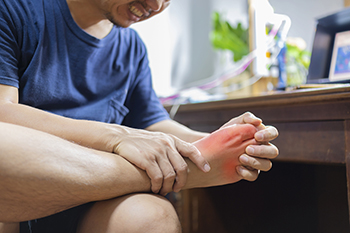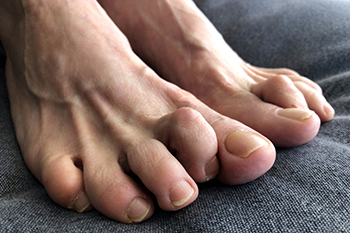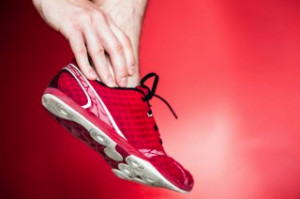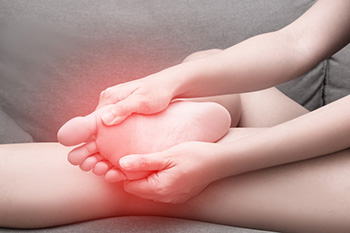Items filtered by date: November 2023
Understanding Pain and Symptoms of Gout

Gout, a form of inflammatory arthritis, unveils its presence through distinctive symptoms that can significantly impact an individual's quality of life. The hallmark of gout is intense joint pain, often reaching its peak during the nighttime. This excruciating pain typically targets the big toe but can affect other joints as well. Swelling and redness accompany the pain, creating a visibly discomforting experience. The affected joint may become tender to the touch, and even the lightest pressure can induce agony. Gout flares are unpredictable, with symptoms emerging suddenly and subsiding gradually. Beyond the acute episodes, persistent discomfort and stiffness may linger, affecting joint mobility. Recognizing these symptoms is essential for early intervention and management. While gout's pain levels can be overwhelming, understanding the nuances of its symptoms empowers individuals to seek timely medical attention, explore effective treatments, and regain control over their joint health. If you have symptoms of gout, it is strongly suggested that you are under the care of a podiatrist who can help you to manage this painful condition.
Gout is a painful condition that can be treated. If you are seeking treatment, contact Jack A. Sasiene, DPM from Texas. Our doctor will treat your foot and ankle needs.
What Is Gout?
Gout is a form of arthritis that is characterized by sudden, severe attacks of pain, redness, and tenderness in the joints. The condition usually affects the joint at the base of the big toe. A gout attack can occur at any random time, such as the middle of the night while you are asleep.
Symptoms
- Intense Joint Pain - Usually around the large joint of your big toe, and it most severe within the first four to twelve hours
- Lingering Discomfort - Joint discomfort may last from a few days to a few weeks
- Inflammation and Redness -Affected joints may become swollen, tender, warm and red
- Limited Range of Motion - May experience a decrease in joint mobility
Risk Factors
- Genetics - If family members have gout, you’re more likely to have it
- Medications - Diuretic medications can raise uric acid levels
- Gender/Age - Gout is more common in men until the age of 60. It is believed that estrogen protects women until that point
- Diet - Eating red meat and shellfish increases your risk
- Alcohol - Having more than two alcoholic drinks per day increases your risk
- Obesity - Obese people are at a higher risk for gout
Prior to visiting your podiatrist to receive treatment for gout, there are a few things you should do beforehand. If you have gout you should write down your symptoms--including when they started and how often you experience them, important medical information you may have, and any questions you may have. Writing down these three things will help your podiatrist in assessing your specific situation so that he or she may provide the best route of treatment for you.
If you have any questions, please feel free to contact our office located in Lake Jackson, TX . We offer the newest diagnostic and treatment technologies for all your foot care needs.
Causes and Treatment of Hammertoe

Hammertoe is a condition where one or more toes exhibit an abnormal bending at the middle joint. In most cases of hammertoe, the second toe is affected. This prevalent foot deformity can lead to discomfort and biomechanical complications. The causes of hammertoe are diverse. Included are an unusually long metatarsal or toe bone, poor alignment of foot joint surfaces, and prolonged wear of ill-fitting shoes. The constriction imposed by tight or narrow shoes often aggravates the condition and potentially causes calluses, corns, ulcers, and metatarsal pain. Treatment for hammertoe by a podiatrist aims at alleviating pain and preventing complications, with a focus on wearing appropriate footwear that features a wide toe box to reduce pressure. Additionally, toe pads and orthotics may be recommended to shield the toes from any shoe related discomfort. Prompt treatment of skin irritations and ulcers is essential. Surgical intervention becomes an option when other measures fail to relieve pain and disability. Its aim is to straighten the rigidly fixed toe deformity and correct its alignment. If you suspect a hammertoe or experience foot pain, it is suggested that you make an appointment with a podiatrist for an examination and treatment options.
Hammertoe
Hammertoes can be a painful condition to live with. For more information, contact Jack A. Sasiene, DPM from Texas. Our doctor will answer any of your foot- and ankle-related questions.
Hammertoe is a foot deformity that affects the joints of the second, third, fourth, or fifth toes of your feet. It is a painful foot condition in which these toes curl and arch up, which can often lead to pain when wearing footwear.
Symptoms
- Pain in the affected toes
- Development of corns or calluses due to friction
- Inflammation
- Redness
- Contracture of the toes
Causes
Genetics – People who are genetically predisposed to hammertoe are often more susceptible
Arthritis – Because arthritis affects the joints in your toes, further deformities stemming from arthritis can occur
Trauma – Direct trauma to the toes could potentially lead to hammertoe
Ill-fitting shoes – Undue pressure on the front of the toes from ill-fitting shoes can potentially lead to the development of hammertoe
Treatment
Orthotics – Custom made inserts can be used to help relieve pressure placed on the toes and therefore relieve some of the pain associated with it
Medications – Oral medications such as anti-inflammatories or NSAIDs could be used to treat the pain and inflammation hammertoes causes. Injections of corticosteroids are also sometimes used
Surgery – In more severe cases where the hammertoes have become more rigid, foot surgery is a potential option
If you have any questions, please feel free to contact our office located in Lake Jackson, TX . We offer the newest diagnostic and treatment technologies for all your foot care needs.
How Podiatrists Can Detect and Treat Running Injuries

Runners visit podiatrists for initial consultations on lower extremity injuries, knowing that identifying the cause is as important as addressing the symptoms. As a practitioner, gaining a runner's trust is essential, which involves showing understanding of their training and equipment, plus being attentive to their detailed injury accounts. A thorough examination is critical, including both static biomechanical and dynamic gait assessments. This is ideally done with the runner in their usual footwear and attire for complete lower extremity visibility. Common injuries among runners can include plantar fasciitis, Achilles tendon injuries, and stress fractures. Regardless of the injury, the aim of treating runners is to ensure their swift yet secure comeback to running. Important to treatment is effective communication and aligning expectations regarding outcomes which are key to supporting patients and helping them stay balanced through challenging periods of recovery. If you are a runner and have experienced a foot or ankle injury, it is suggested that you make an appointment with a podiatrist who can offer appropriate injury prevention techniques.
All runners should take extra precaution when trying to avoid injury. If you have any concerns about your feet, contact Jack A. Sasiene, DPM of Texas. Our doctor will treat your foot and ankle needs.
How to Prevent Running Injuries
There are a lot of mistakes a runner can make prior to a workout that can induce injury. A lot of athletes tend to overstretch before running, instead of saving those workouts for a post-run routine. Deep lunges and hand-to-toe hamstring pulls should be performed after a workout instead of during a warmup. Another common mistake is jumping into an intense routine before your body is physically prepared for it. You should try to ease your way into long-distance running instead of forcing yourself to rush into it.
More Tips for Preventing Injury
- Incorporate Strength Training into Workouts - This will help improve the body’s overall athleticism
- Improve and Maintain Your Flexibility – Stretching everyday will help improve overall performance
- “Warm Up” Before Running and “Cool Down” Afterward – A warm up of 5-10 minutes helps get rid of lactic acid in the muscles and prevents delayed muscle soreness
- Cross-Training is Crucial
- Wear Proper Running Shoes
- Have a Formal Gait Analysis – Poor biomechanics can easily cause injury
If you have any questions, please feel free to contact our office located in Lake Jackson, TX . We offer the newest diagnostic and treatment technologies for all your foot care needs.
Symptoms and Treatment of Freiberg's Disease

Freiberg's disease, a condition affecting the bones in the ball of the foot, often near the base of the big toe, can cause substantial pain and discomfort. It is more apt to affect runners, dancers, and women who wear high heels. Freiberg's disease sometimes affects people with a short big toe and a longer second toe. It is characterized by the death of tissue in the foot's bones, primarily the second metatarsal head. Symptoms can include persistent pain, described as a sharp, aching discomfort. Swelling and stiffness in the affected joint can hinder mobility. The pain worsens during weight-bearing activities, especially when pushing off of the foot and wearing high-heeled shoes. Freiberg's disease is more prevalent in adolescent girls experiencing rapid growth, or people with specific bone structure issues. Diagnosis by a podiatrist involves taking X-rays to confirm and assess the condition's severity. Treatment options include corticosteroid injections to help manage pain and inflammation during flare-ups. Footwear modifications, including low-heeled shoes with thicker soles and rounded heels, can help redistribute pressure across the foot. Custom orthotics also can relieve pressure on affected joints. Surgery, which is rarely required, may involve removing the second metatarsal bone for unmanageable, persistent pain. If you suspect you may be suffering from Freiberg's disease, it is suggested that you make an appointment with a podiatrist for an accurate diagnosis and personalized treatment plan.
Some foot conditions may require additional professional care. If you have any concerns, contact Jack A. Sasiene, DPM of Texas. Our doctor can provide the care you need to keep you pain-free and on your feet.
Rare Foot Conditions
The majority of foot conditions are common and can be treated by a podiatrist. Standard diagnostic procedures are generally used to identify specific conditions and treatment can be rendered. A podiatrist also treats rare foot conditions which can be difficult to diagnose and may need extra attention and care.
There are many rare foot conditions that can affect children. Some of these can include:
- Freiberg’s disease
- Kohler’s disease
- Maffucci syndrome
Freiberg’s disease - This can be seen as a deterioration and flattening of a metatarsal bone that exists in the ball of the foot. It typically affects pre-teen and teenage girls, but can affect anyone at any age. Symptoms that can accompany this can be swelling, stiffness, and the patient may limp.
Kohler’s disease - This often targets the bone in the arch of the foot and affects younger boys. It can lead to an interruption of the blood supply which ultimately can lead to bone deterioration. The patient may limp or experience tenderness, swelling, and redness.
Maffucci syndrome - This affects the long bones in a child’s foot leading to the development of abnormal bone lesions. They are benign growths and typically develop in early childhood and the bones may be susceptible to breaking.
A podiatrist can properly diagnose and treat all types of rare foot conditions. If your child is affected by any of these symptoms or conditions, please don’t hesitate to call our office so the correct treatment method can begin.
If you have any questions, please feel free to contact our office located in Lake Jackson, TX . We offer the newest diagnostic and treatment technologies for all your foot care needs.

